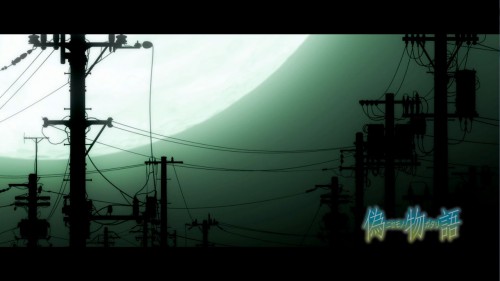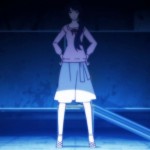Somehow I managed to never write anything about a seriously good series that came out a couple years back called Bakemonogatari. It basically revolved around Araragi Koyomi, a high school student that has an overdeveloped sense of justice. Each plot arc involves him coming across a girl that is in the midst of some kind of personal crisis that is manifesting in a supernatural way. The first arc’s victim was a classmate named Senjougahara, who was beautiful and aloof, and had completely lost her weight. By which I don’t mean she was anorexic, but rather that she didn’t weigh anything. With the help of a mysterious occult expert that appears to operate out of an abandoned cram-school, Araragi invariably finds a way to remove or mitigate the girls’ curses and the story moves on to the next incident. Nisemonogatari is the sequel or continuation of Bakemonogatari. Four episodes in we are getting to the meat of the current victim’s plight. Events are conspiring to fill in a bit of the implied back-story from the first season, giving more of an impression that there is truly an over-arcing plot to the story.
The character designs and voice acting are excellent, often provoking conflicting reactions that help keep the presentation of the story off-balance. I found myself sympathizing with characters that on the surface I did not like. The pacing is stylishly disjointed in a manner resembling Sayonara Zetsubo Sensei, with oddly-timed cuts and changes in visual style. Again this helps create a form of dramatic tension that might not otherwise be present. Production quality is quite high, with each plot arc having its own intro sequence in the first series, and each episode changing its intro and ending sequences, a rare expense in popular animation. Sometimes I suspect the production companies do this specifically to appeal to a certain flavor of fanboy that sees such changes as an sure sign of quality, but in this case it’s no ruse.
Highly recommended as of four episodes into the second series.




Boy, high quality is an understatement. Akiyuki Shinbo gives everything he has. It is not just an anime anymore, it’s more like a play with characters moving in contemporary paintings to a script written by Nisio Isin and voiced by every VA they had as a first choice. They got so much cash from Madoka that they are demonstrating what a show with embedded style and context can be without ANY restrictions – finacial, technical, schedule, staff etc. That’s quite something, I have to say.
Shinbo tried to achieve this with Bakemonogatari during the TV airing, but how it ended in the first round – we all know. Half time of episodes were blank screens and three last of them were aired across one year time. That worked the first time as fans gave him credit and expected alot from blurays, but with Nisemonogatari it would be like a slap in the face after all the DVD’s and BD’s of Bake, Madoka and some others we bought. He knows it and that’s why he is one of the best directors out there right now.
Still, I’m a SHAFTard, so I guess that makes my opinion invalid in a way.
This show definitely gives the impression that no corners were cut in its production, that’s for sure. There are times when things feel a bit roto-scoped, which always strikes me as cheap even when it is clearly being done for effect and only for a moment. The release schedule for the first season’s ending wasn’t something I wanted to get into (it was rather frustrating from my perspective) as it’s basically irrelevant to anybody just picking up the title today.
I wasn’t aware of the back-office business end of the *monogatari animation. Thanks for the insight!